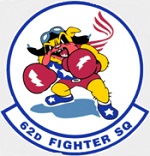Hobby Master HA8412 USAAF Republic P-47D Thunderbolt Fighter - Capt. Frederick Christensen, 62nd Fighter Squadron "Spike War Dawgs", 56th Fighter Group, England, 1944 (1:48 Scale)
"Why should we have a navy at all? There are no enemies for it to fight except apparently the Army Air Force."
- General Carl Spaatz, Commander of the US 8th Army Air Force, after WWII
 Nicknamed the "Jug" for its bulky shape, the Republic P-47 Thunderbolt was considered a monster of a machine. Despite its size, the Thunderbolt proved to be a fast and maneuverable warbird able to hold its own in combat. In fact, when Allied pilots climbed aboard a P-47, they knew the were in control of a fighting machine with enormous power. More importantly, they knew that if their aircraft was hit but gunfire, they had an excellent chance of making it home.
Nicknamed the "Jug" for its bulky shape, the Republic P-47 Thunderbolt was considered a monster of a machine. Despite its size, the Thunderbolt proved to be a fast and maneuverable warbird able to hold its own in combat. In fact, when Allied pilots climbed aboard a P-47, they knew the were in control of a fighting machine with enormous power. More importantly, they knew that if their aircraft was hit but gunfire, they had an excellent chance of making it home.
Refinements to the Thunderbolt continued throughout its career, leading to the P-47D, which was the most produced version with 12,558 built. The "D" model actually consisted of a series of evolving production blocks, the last of which were visibly different from the first.
The first P-47Ds were actually the same as P-47Cs. Republic could not produce Thunderbolts fast enough at its Farmingdale plant on Long Island, so a new plant was built at Evansville, Indiana. The Evansville plant first built a total of 110 P-47D-1-RAs, which were completely identical to P-47C-2s. Farmingdale aircraft were identified by the -RE suffix after the block number, while Evansville aircraft were given the -RA suffix.
The P-47D-1 through P-47D-6, the P-47D-10, and the P-47D-11 successively incorporated changes such as the addition of more engine cooling flaps around the back of the cowl to reduce the engine overheating problems that had been seen in the field. Engines and engine subsystems saw refinement, (the P-47D-10 introduced the R-2800-63, replacing the R-2800-21 seen in previous P-47s) as did the fuel, oil and hydraulic systems. Additional armor protection was also added for the pilot.
The P-47D-15 was produced in response to requests by combat units for increased range. "Wet" (equipped with fuel plumbing) underwing pylons were introduced to allow a bomb or drop tank pressurized by vented exhaust air to be carried under each wing, in addition to the belly tank.
Pictured here is a 1:48 scale replica of a P-47D Thunderbolt fighter that was piloted by Capt. Frederick Christensen, who was attached to the 62nd Fighter Squadron, 56th Fighter Group, then deployed to England during 1944.
Sold Out!
Dimensions:
Wingspan: 10-inches
Length: 8-3/4-inches
Release Date: July 2017
 Historical Account: "Spike War Dawgs" - The 62d Fighter Squadron was constituted as the 62d Pursuit Squadron as part of the 56th Pursuit Group at Savannah, Georgia, on January 15th, 1941. The squadron immediately began training for its wartime missions under III Fighter Command, rapidly transitioning through the P-35, P-36, P-39, and P-40 aircraft. On December 7th, 1941, the 62d stepped up to defend the Northeastern United States from anticipated enemy air attack while it converted to the P-47 aircraft and prepared to deploy overseas, operating under the I Fighter Command, New York Fighter Wing in the early months of 1942.
Historical Account: "Spike War Dawgs" - The 62d Fighter Squadron was constituted as the 62d Pursuit Squadron as part of the 56th Pursuit Group at Savannah, Georgia, on January 15th, 1941. The squadron immediately began training for its wartime missions under III Fighter Command, rapidly transitioning through the P-35, P-36, P-39, and P-40 aircraft. On December 7th, 1941, the 62d stepped up to defend the Northeastern United States from anticipated enemy air attack while it converted to the P-47 aircraft and prepared to deploy overseas, operating under the I Fighter Command, New York Fighter Wing in the early months of 1942.
It was redesignated 62d Fighter Squadron on May 15th, 1942, and deployed to RAF Kings Cliffe (AAF-367), England on January 9th, 1943. It was declared operationally ready two months later and flew its first combat missions on April 13th. The squadron was given fuselage code "LM" and operated from several RAF stations during the war, flying the P-47C Thunderbolt as an VIII Fighter Command bomber-escort unit for B-17 Flying Fortresses and beginning in 1944 for B-24 Liberators attacking enemy targets in Occupied Europe. After the end of the war in Europe, the squadron demobilized in England, and was inactivated as an administrative unit on October 18th, 1945.


